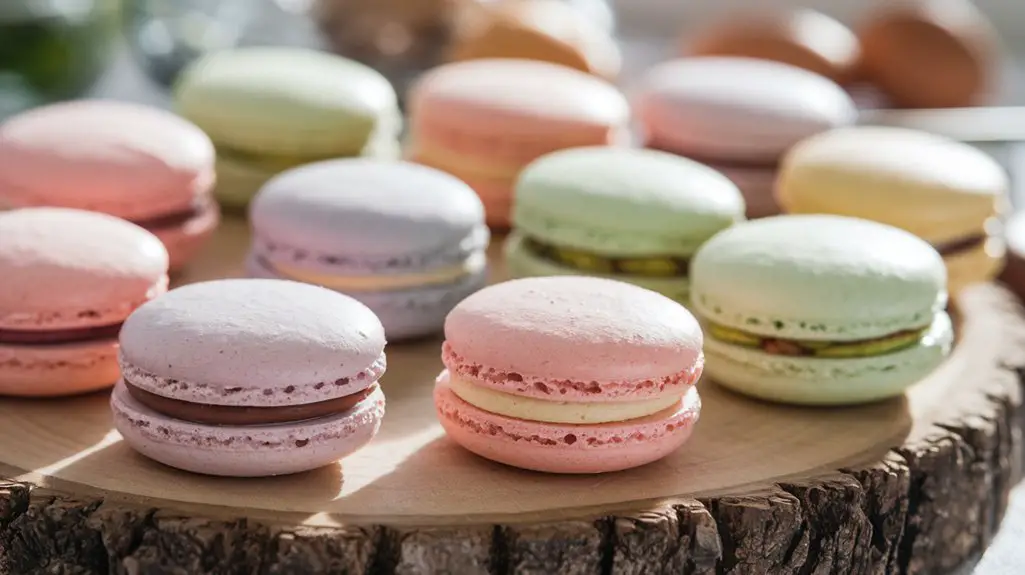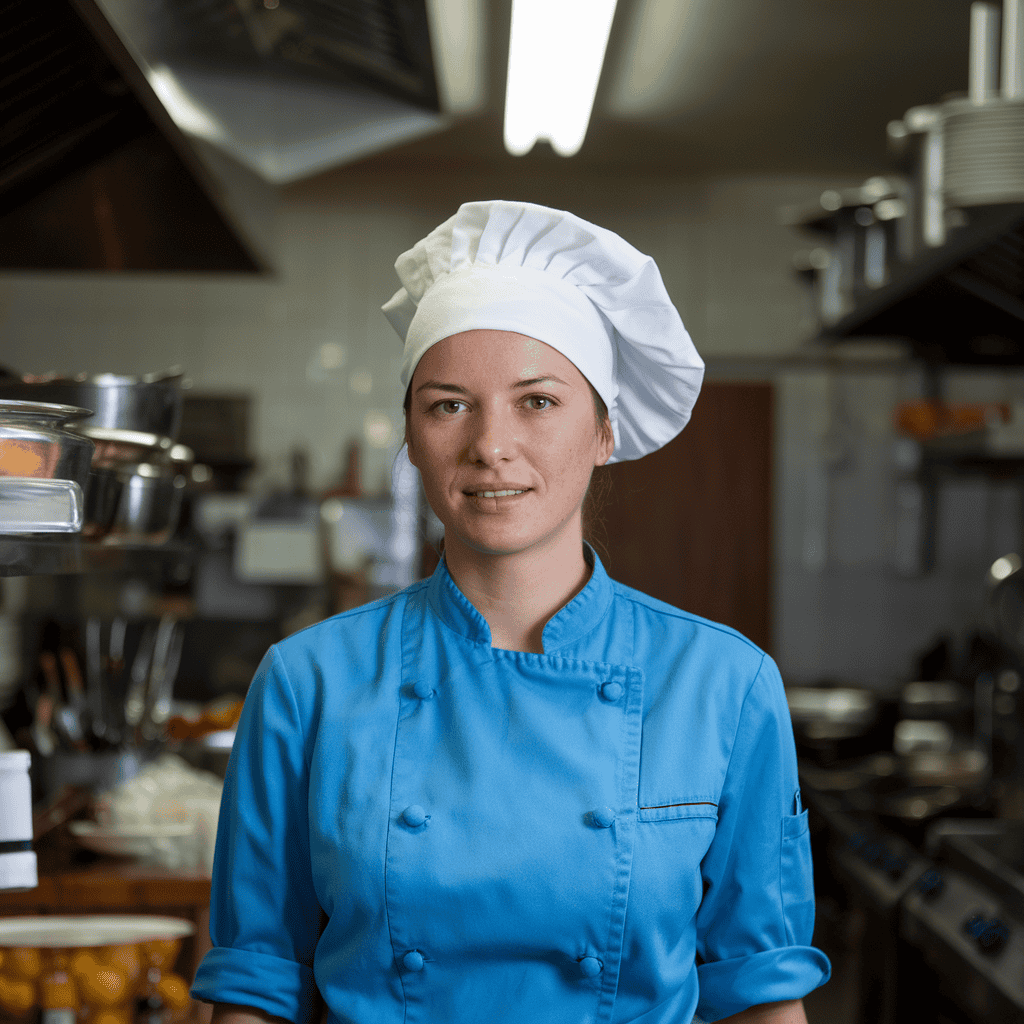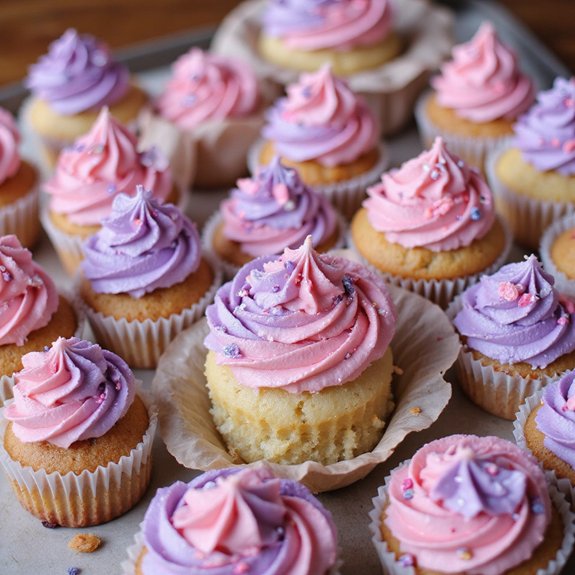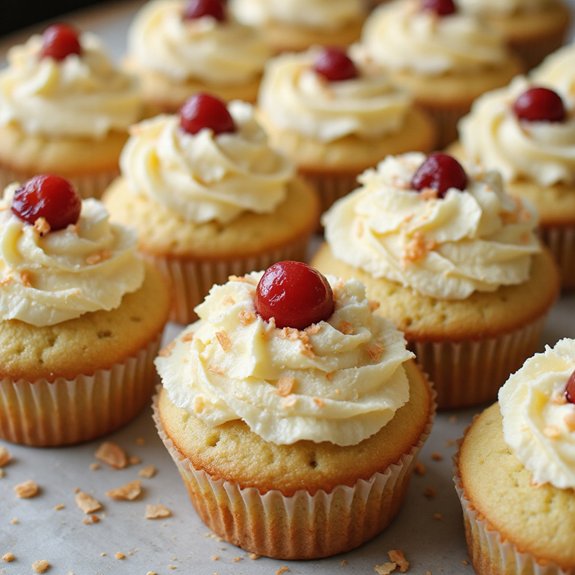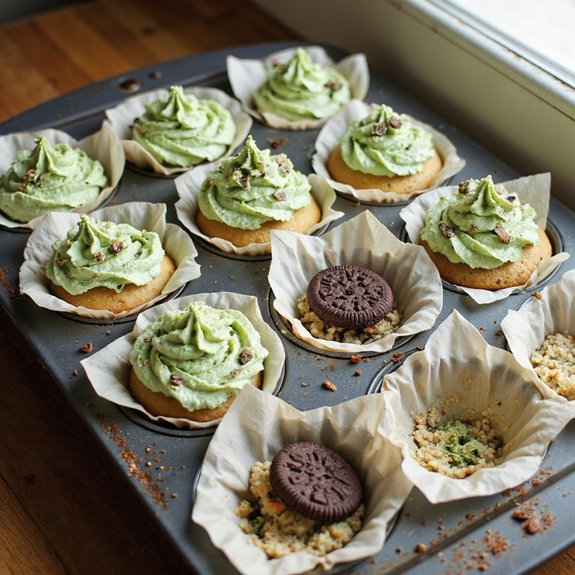Crafting macarons demands precision and patience, beginning with sifting almond flour and powdered sugar to achieve a smooth batter.
You’ll whip egg whites to stiff peaks before folding in the dry ingredients with care.
Piping the mixture onto a baking sheet, let it rest for an essential skin formation.
Baking at 300°F develops the signature feet and golden hue.
Choose your favorite ganache or buttercream for filling, but first, let’s dive deeper into this meticulous process.
Kitchen Tools Required
To successfully create macarons, you’ll need a precise set of kitchen tools to guarantee accuracy and consistency in your baking process.
A digital kitchen scale is essential for weighing ingredients with precision.
Use a fine mesh sieve to sift almond flour and powdered sugar, making certain a smooth batter.
A stand mixer with a whisk attachment will help you achieve perfect meringue with stiff peaks.
| Tool | Purpose |
|---|---|
| Digital Kitchen Scale | Accurately weigh ingredients |
| Fine Mesh Sieve | Sift almond flour and powdered sugar |
| Stand Mixer | Whip egg whites to stiff peaks |
A silicone baking mat or parchment paper is vital for even baking.
A piping bag with a round tip will allow you to pipe uniform circles.
Finally, a reliable oven thermometer guarantees precise baking temperature.
Recipe
Macarons are a delightful French treat that bring a touch of elegance to any occasion.
With their delicate shells and endless filling possibilities, they’re a favorite among dessert enthusiasts.
Creating the perfect macaron may seem intimidating, but with careful attention to detail and a little practice, you can master these confections in your own kitchen.
The key lies in achieving the right meringue consistency, folding technique, and baking method to guarantee that each macaron has a crisp exterior and a chewy interior.
To begin, you’ll need to gather your ingredients and prepare your workspace.
Start by sifting almond flour and powdered sugar together to remove any lumps and guarantee a smooth texture.
Whip the egg whites until they form stiff peaks, gradually adding granulated sugar to stabilize the meringue.
Gently fold the dry ingredients into the meringue, ensuring you maintain the airiness of the mixture.
If desired, add food coloring to achieve your preferred hue.
Pipe the batter onto a baking sheet lined with parchment paper, let them rest until a skin forms, and then bake until the macarons develop their characteristic “feet”.
Ingredients:
- Almond flour
- Powdered sugar
- Egg whites
- Granulated sugar
- Food coloring (optional)
- Cream of tartar (optional)
- Filling of choice (e.g., buttercream, ganache, fruit preserves)
Once your macarons have baked and cooled, fill them with your chosen filling by spreading or piping it onto the flat side of one shell and sandwiching it with another.
The possibilities for fillings are endless, ranging from classic buttercream to rich chocolate ganache or tangy fruit preserves.
Allow the filled macarons to mature in the refrigerator for at least 24 hours to allow the flavors to meld and the texture to improve.
Serve at room temperature to enjoy their full flavor and delicate texture.
For best results, guarantee all your equipment is clean and free of any grease or moisture, as this can prevent proper meringue formation.
Additionally, be mindful of the weather, as humidity can affect the meringue and baking process.
Start with a simple flavor and filling if you’re new to making macarons to get a feel for the technique.
Remember, each batch offers an opportunity to refine your skills, so don’t be discouraged if your first attempts aren’t perfect.
With patience and practice, you’ll be able to create stunning and delicious macarons.
Cook & Prep Time
Crafting macarons requires meticulous precision with your time management.
Begin by allocating a total of approximately 1 hour and 45 minutes.
Set aside 30 minutes for preparation: sifting, whipping, and folding the ingredients.
This foundational stage demands focus to achieve the perfect batter consistency.
Next, allow 30 minutes for the resting phase, essential for forming a skin on the piped batter.
During this time, preheat your oven to guarantee ideal baking conditions.
The baking process requires 15 to 20 minutes, during which you should closely monitor the development of macaron feet and shell integrity.
Finally, allocate 20 to 25 minutes for cooling and filling assembly.
Adhering to these timeframes guarantees a seamless macaron-making experience, resulting in exquisite confections.
Cooking Steps
To begin the macaron-making process, sift the almond flour and powdered sugar together thoroughly to eliminate any clumps that could disrupt the texture.
Next, beat the egg whites until they reach stiff peaks, then carefully fold in the almond mixture, maintaining the aeration.
Allow the piped batter to rest until a skin forms on the surface before baking until the shells are golden brown with characteristic “feet”.
Step 1. Sift Almond Flour, Sugar
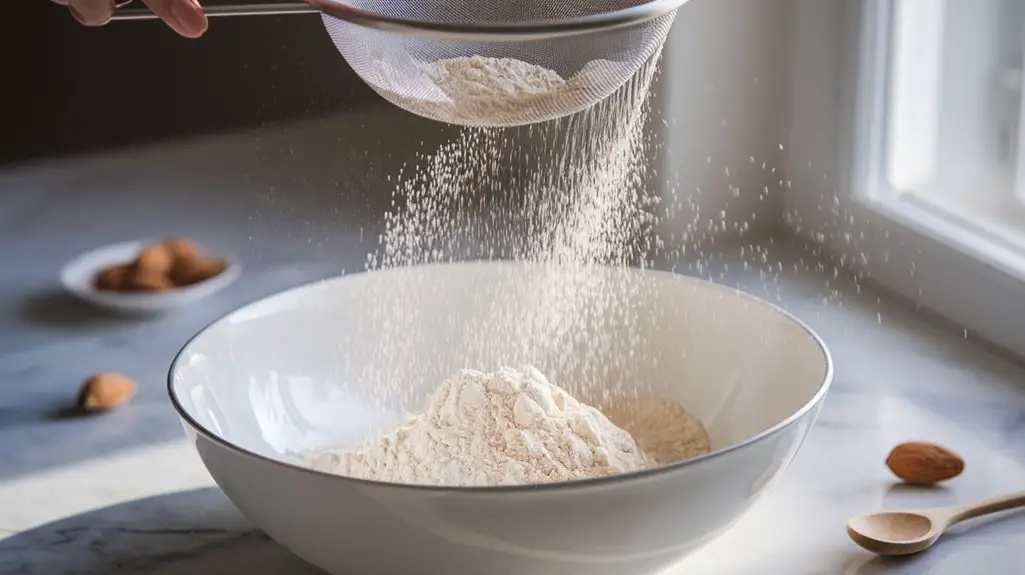
Begin by ensuring your workspace and tools are clean and dry to prevent any interference with the delicate balance of your ingredients.
Using a fine-mesh sieve, sift the almond flour and powdered sugar together into a large mixing bowl.
This process is essential to eliminate any clumps, ensuring a smooth macaron shell.
As you sift, maintain a steady hand to evenly distribute the ingredients.
Remember, precision in this step affects texture and appearance. Pay attention to:
- Consistency: Aim for a fine, lump-free powder.
- Uniformity: Combine thoroughly to blend the almond and sugar.
- Patience: Take your time to avoid missing any lumps.
Step 2. Beat Egg Whites to Peaks
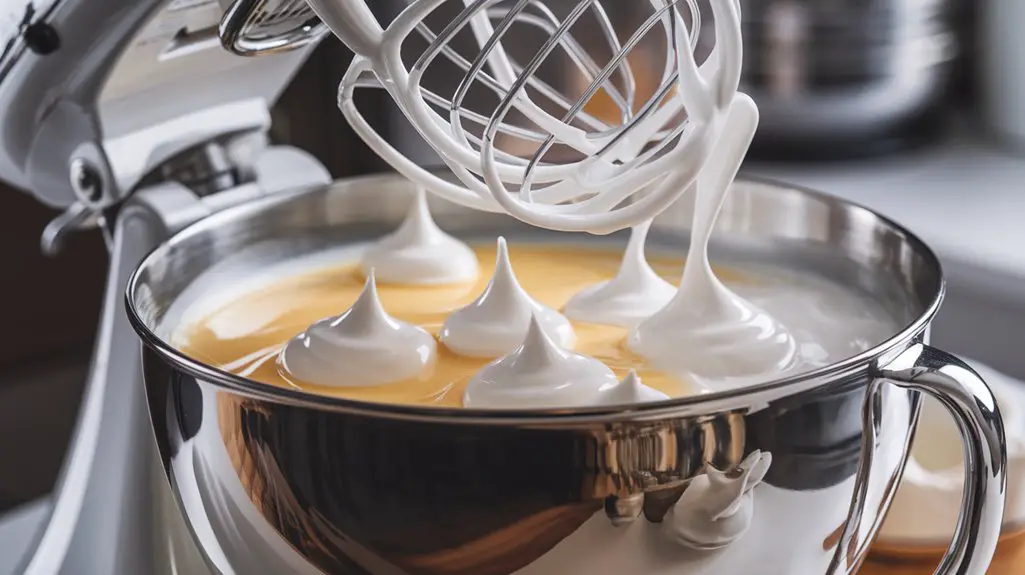
Whisk the egg whites in a clean, grease-free bowl until they start to foam. Gradually add granulated sugar.
Incorporate a pinch of cream of tartar to stabilize the meringue if desired.
Continue whisking at a medium speed until you observe soft peaks. Increase the speed to high, continuing until stiff peaks form.
The meringue should be glossy, with peaks that stand firm without collapsing.
| Step | Description | Visual Cue |
|---|---|---|
| Foaming | Egg whites foam | Bubbles form |
| Soft Peaks | Peaks form but droop | Soft, rounded peaks |
| Stiff Peaks | Peaks stand firm | Glossy, firm peaks |
| Stability | Meringue holds shape | No droop when inverted |
Ensure no yolk is present, as fat can hinder peak formation.
Step 3. Fold Almond Mixture Gently
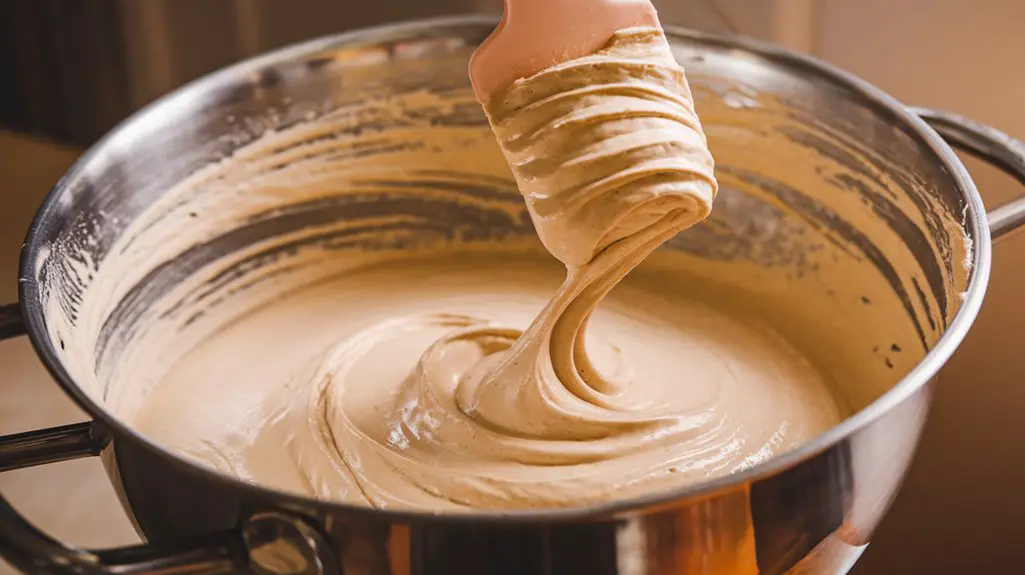
Carefully fold the sifted almond flour and powdered sugar mixture into the meringue, making sure you don’t deflate the whipped egg whites.
Use a rubber spatula to sweep around the bowl’s edge, lifting the mixture from the bottom.
Rotate the bowl with each fold, maintaining a gentle rhythm to preserve the meringue’s volume.
Observe the batter’s consistency, aiming for a smooth, flowing texture that ribbons off the spatula.
Here’s why precision matters:
- Achieving Perfect Consistency: Guarantees uniformity in macaron shells.
- Maintaining Meringue Structure: Preserves the airy, delicate texture.
- Creating Smooth Shells: Prevents lumps and hollows.
Don’t rush; patience here yields beautifully smooth and even macarons.
Your attentiveness is the key to achieving that coveted balance of crispness and chewiness.
Step 4. Rest Batter for Skin Formation
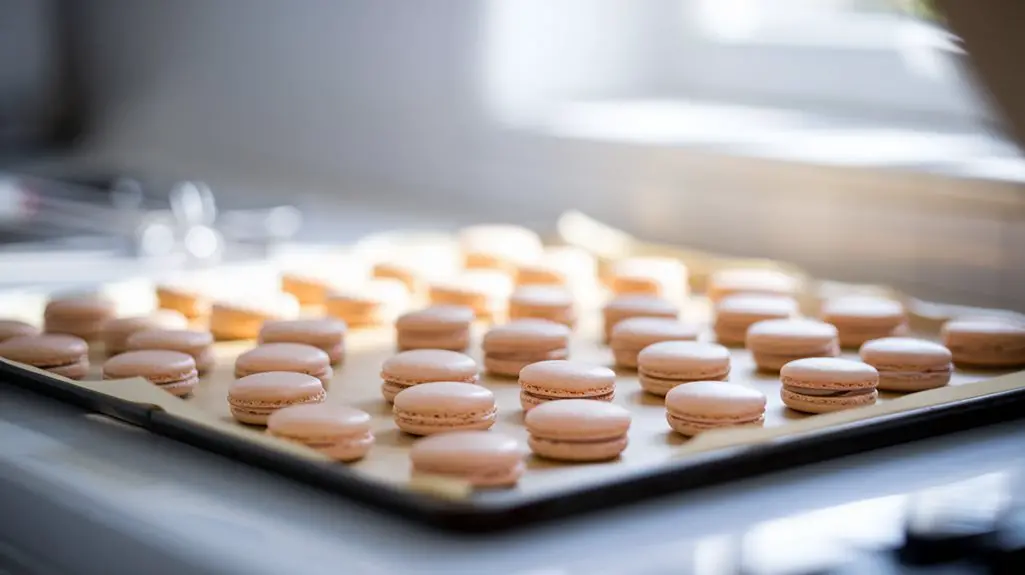
Allow the piped macaron batter to rest on the baking sheet until a skin forms on the surface.
This step is essential for achieving the characteristic smooth top and preventing cracking.
Depending on humidity, rest for 20 to 40 minutes. Test by lightly touching; the batter shouldn’t stick to your finger.
| Resting Time | Skin Formation Check |
|---|---|
| 20 minutes | Touch lightly |
| 30 minutes | No stickiness |
| 40 minutes | Firm skin |
| Adjust time | Based on humidity |
Ensure the kitchen is draft-free to expedite skin formation.
Avoid skipping this step, as it directly impacts the macaron’s lift and structure.
Monitor environmental conditions, adjusting rest time as needed for best results.
Once a skin has formed, proceed to the next step in baking preparation.
Step 5. Bake Until Golden Brown
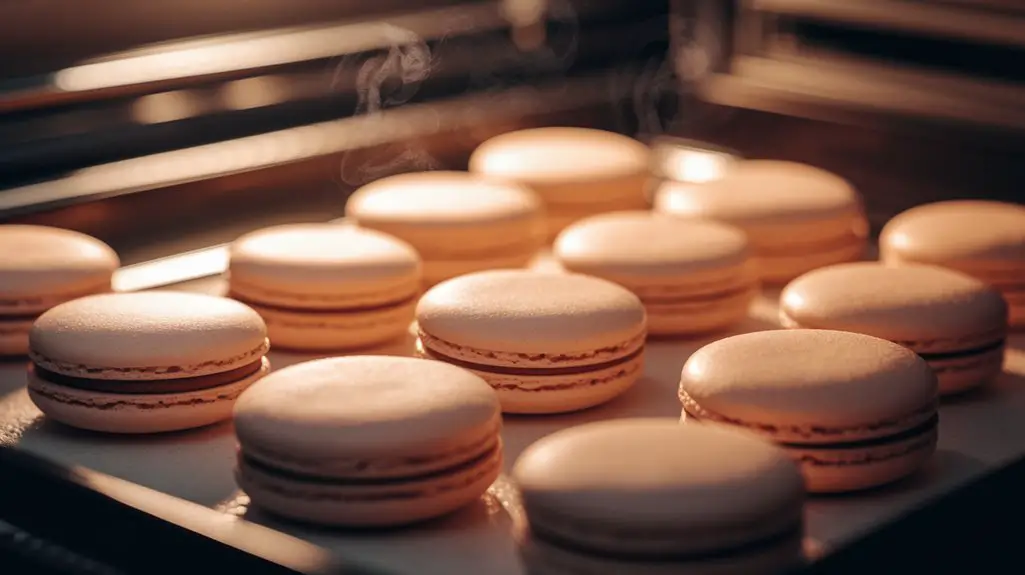
Once the macaron batter has rested and formed a skin, it’s time to bake them to perfection. Preheat your oven to 300°F (150°C).
Place the baking tray on the middle rack to guarantee even heat distribution. Bake for 14-16 minutes, monitoring closely. Look for these critical signs:
- Shells develop feet: This ruffled base indicates proper rise.
- Surface is smooth and shiny: A hallmark of well-developed macarons.
- Light golden edges: Shows they’re perfectly cooked without over-browning.
Gently touch a shell; it should feel firm and not wobble. If they’re underbaked, the centers will collapse.
Carefully remove the tray and allow them to cool completely on the parchment.
These meticulous steps guarantee your macarons are a delight to behold and taste.
Nutrition Information
As you complete the macaron-making process, evaluating the nutritional profile becomes important.
Each macaron contains a mix of carbohydrates, fats, and proteins, primarily from almond flour and eggs.
It’s essential to be aware of their caloric content, especially if you’re monitoring your intake. Consider these key nutritional aspects:
- Caloric Density: Each macaron can range from 70 to 100 calories, depending on the filling and size.
- Sugar Content: High sugar levels contribute to sweetness but should be consumed in moderation to maintain a balanced diet.
- Allergens: Almond flour and eggs are common allergens, vital for those with sensitivities.
Final Thoughts
Mastering the art of macaron making requires precision and patience, but the end result is a demonstration of your skill and dedication.
You’ve successfully navigated through meticulous steps, from sifting almond flour to achieving meringue perfection.
Each stage demands attention to detail and adherence to technique.
Remember, practice refines your process and enhances results, so don’t be discouraged by initial attempts.
Evaluate factors like humidity, which can impact meringue stability, and adjust your approach as needed.
Consistently assess your progress, noting any variations in texture or appearance.
With each batch, you strengthen your understanding of the macaron’s delicate balance.
Celebrate your accomplishments, knowing that each macaron showcases your growing expertise.
You’ve achieved a culinary feat that combines artistry and science. Enjoy the fruits of your labor.
Frequently Asked Questions
How Can I Prevent My Macarons From Cracking?
Make certain your meringue achieves stiff peaks, preventing under-mixing. Allow piped batter to rest until a skin forms, avoiding moisture exposure. Precisely monitor oven temperature; use an oven thermometer. These steps minimize cracking in your macarons.
What Is the Ideal Temperature for Baking Macarons?
You’ll want to bake macarons at 300°F (150°C) for 14-16 minutes. Make certain your oven’s accurately calibrated using an oven thermometer, as temperature fluctuations can affect the macaron’s structure and lead to imperfections.
How Long Should Macarons Rest Before Baking?
Guarantee macarons rest for 20-30 minutes pre-bake. This allows a skin to form, preventing cracking. Touch gently; if they’re dry, proceed with baking. Monitor humidity levels, as higher moisture may extend resting time.
Can I Use Liquid Food Coloring for Macarons?
You can use liquid food coloring for macarons, but it may alter the batter’s consistency. Opt for gel or powdered coloring for better results, as they provide vibrant hues without affecting the meringue’s stability.
How Do I Store Macarons to Maintain Freshness?
Store macarons in an airtight container, layering parchment paper between them. Refrigerate for up to a week, ensuring constant temperature. For longer storage, freeze for up to three months. Thaw at room temperature before serving for ideal texture.

